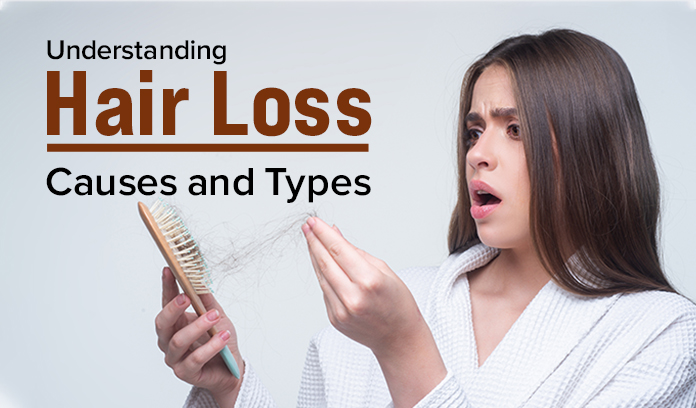Hair loss is a common concern that affects people of all ages and genders.
Whether you’ve noticed a receding hairline, thinning strands, or more hair in your shower drain, understanding the causes and types of hair loss is the first step toward finding effective solutions.
In this informative blog post, we’ll break down the complex topic of hair loss into clear categories and explore the various factors that can contribute to it.
Causes of Hair Loss:
Hair loss can occur due to a multitude of factors, and identifying the cause is crucial for effective management. Here are some primary causes:
- Androgenetic Alopecia: Also known as male or female pattern baldness, this is a genetic condition that causes hair follicles to shrink and produce finer hair over time.
- Alopecia Areata: An autoimmune condition that leads to sudden hair loss in small, round patches.
- Telogen Effluvium: A temporary condition caused by stress, illness, surgery, or medication, leading to hair follicles entering a resting phase.
- Traction Alopecia: Hair loss resulting from excessive tension on the hair, often due to tight hairstyles like braids or ponytails.
- Medications: Certain drugs, including chemotherapy agents, can cause hair loss as a side effect.
- Nutritional Deficiencies: Insufficient intake of essential nutrients, such as iron, biotin, and zinc, can lead to hair loss.
- Hormonal Imbalance: Hormonal changes, such as those during pregnancy or menopause, can influence hair growth cycles.
Types of Hair Loss:
Hair loss isn’t one-size-fits-all; it comes in various forms. Here are some common types:
- Androgenetic Alopecia: Characterized by a receding hairline in men and diffuse thinning in women. It’s the most common type of hair loss.
- Alopecia Areata: Sudden hair loss in small, circular patches, which can occur anywhere on the body.
- Telogen Effluvium: Often experienced as increased shedding and thinning of hair, but it’s usually reversible.
- Traction Alopecia: Hair loss due to the constant pulling of hair, commonly seen in individuals who wear tight hairstyles.
- Anagen Effluvium: Hair loss that occurs during the active growth phase (anagen) of the hair follicles, typically due to chemotherapy.
- Scarring Alopecia: Hair loss accompanied by scarring of the scalp, often caused by autoimmune disorders.
Common Misconceptions:
There are several myths surrounding hair loss. Let’s debunk a few:
- Myth: Wearing a hat causes hair loss. False. Hats, when worn loosely, don’t lead to hair loss.
- Myth: Frequent shampooing accelerates hair loss. False. Clean hair is healthy hair and doesn’t contribute to hair loss.
- Myth: Hair loss is only a male issue. False. Women can experience hair loss too, though it may look different.
- Myth: Massaging your scalp can stimulate hair growth. While it’s a good practice for scalp health, it won’t regrow lost hair.
Preventing and Managing Hair Loss:
While not all forms of hair loss are preventable, there are steps you can take to manage it:
- Consult a Healthcare Professional: If you’re concerned about hair loss, seek advice from a healthcare provider to determine the underlying cause and discuss treatment options.
- Nutritional Support: A balanced diet rich in vitamins and minerals can promote healthy hair. Consider supplements if deficiencies are a concern.
- Stress Reduction: Managing stress through relaxation techniques can help prevent stress-induced hair loss.
- Gentle Hair Care: Avoid tight hairstyles and harsh hair treatments that can damage hair and follicles.
- Medications and Treatments: Some hair loss types respond well to medications like minoxidil and finasteride. Consult a healthcare professional for advice.
Conclusion:
Hair loss is a complex issue with various causes and types.
Understanding the specific factors contributing to your hair loss is the first step toward finding an effective solution.
Don’t hesitate to consult with a healthcare professional to address your concerns and explore treatment options tailored to your needs.
Remember that managing hair loss is a holistic journey that may involve lifestyle changes, treatments, and self-care practices to support healthy hair and overall well-being.

